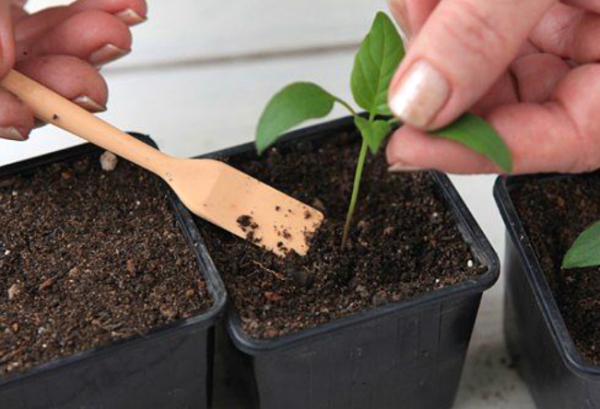 The picking of seedlings is usually called the process of separation of the root part of the seedlings with the aim of transplanting into separate holes for further growth and development of bushes. Diving is also carried out during the transshipment of young shoots from smaller tanks to large ones.
The picking of seedlings is usually called the process of separation of the root part of the seedlings with the aim of transplanting into separate holes for further growth and development of bushes. Diving is also carried out during the transshipment of young shoots from smaller tanks to large ones.
Partial root loss is necessarily carried out in the early stages, when only 2-3 full leaflets are formed on the stems. It is at this stage that plants have enough strength to begin to grow better and grow faster.
Content
Do I need to dive pepper seedlings?
In the process of growing pepper from seeds, the picking stage is a must, because the undivided sprouts will begin to obscure each other, and the stems themselves will stretch unnecessarily and become too weak to bring the first crop in a few months.
This is true both for sown seeds in one container, and planting them in separate small pots. In the second case, a neat transplant is performed in a container with a large volume. If the seeds are laid immediately in a large pot, the developing roots will not be able to completely process the incoming moisture, and the soil will begin to sour quickly (thereby creating adverse conditions for growing pepper). If the plant is left in small pots, then the stems will simply stop in development and will not be able to bring a crop.
Thus, it turns out that picking is an obligatory step in growing peppers, but it should be carried out as correctly and accurately as possible. Thanks to this, seedlings will be able to:
- grow and develop faster;
- become more resistant to various diseases;
- absorb more nutrients in the earth;
- give a good harvest in the form of dense large fruits.
If possible, it is better to sow pepper seeds in separate small pots or cups, and when transplanting to a new container, use the entire lump of land with roots sprouted in it. Due to this, the loss of roots will be minimal, which means that stress for the plant itself will not be detrimental.
Advantages and disadvantages of diving seedlings
The pick phase requires maximum accuracy and accuracy. In this case, the list of its advantages should include: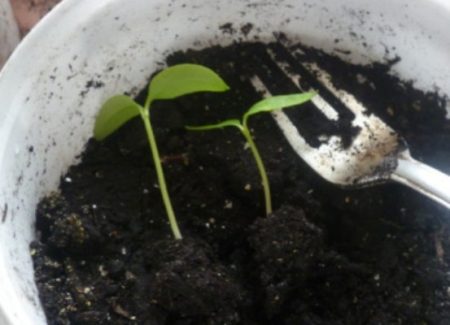
- An opportunity to increase the place for the further development of seedlings. This is due to the fact that the sprouts planted together begin to oppress each other, and there are not enough nutrients available in the soil. If, when sowing seeds, it is necessary to adhere to a distance between the holes of about 2 - 3 cm, then the full development of the bushes is possible if there will be at least 35 - 40 cm between them.
- Sorting seedlings. Only strong and properly developing seedlings are subject to picking and further planting in the ground. Underdeveloped and too weak plants must be removed, because they will no longer be able to produce the expected yield, and therefore will not require unnecessary effort, time and maintenance costs.
- Timely fight against diseases. When growing seedlings from seeds, all plants must be examined for possible manifestations of ailments, for example, lesions of the black leg. A timely picking of plants allows you to remove diseased seedlings and thereby save healthy ones. At the same time, accurate picking makes the root system stronger, which means that it becomes less vulnerable to most diseases, for example, fusarium or apical aphids.
- The possibility of increasing the future crop.The pick provides for the removal of the growth point of the main root. It is this stage that provokes the development of the accessory and lateral roots, which are located in the upper most fertile soil layer. Thus, the plant receives more nutrients, which means it develops and grows better, forming the ovaries of large fruits.
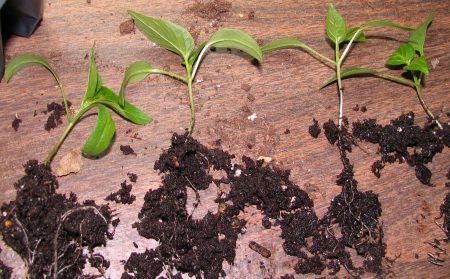
In the work of gardeners associated with picking pepper seedlings, there are a number of disadvantages. The list should include:
- Creation of great and often detrimental stress for immature and too weak plants, which negates any benefits.
- In working with seedlings with your own hands, you can transfer infections from diseased plants to healthy ones, thereby depriving them of a chance for further full development and fruiting.
- Picking seedlings of pepper requires maximum attention and accuracy, which is not always possible even with the most experienced gardeners.
- Too late picking can lead to the formation of too many lateral roots, which in turn provokes a delay in the formation of ovaries and ripening of the fruits themselves.
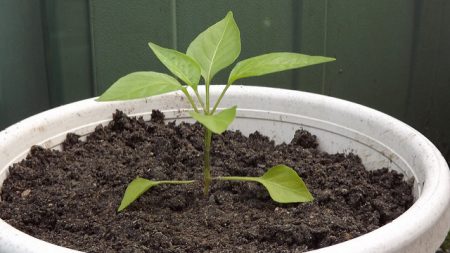
Dive Dates
An equally important requirement for a successful picking of pepper seedlings is the timeliness of the work itself. Too early separation of seedlings can delay further development or completely destroy the plant, as the seedling will not have enough strength to adapt to new growing conditions. In this case, postponement of the pick can lead to the fact that the roots of seedlings are intertwined and damage to root systems during separation cannot be safe.
The optimal time for diving seedlings is 15 - 20 days after the appearance of sprouts. By this period, 2 to 3 full leaflets, not cotyledons, should form on the stems. In plants with only cotyledon leaves formed, the root system is still too weak and the plant is not able to take root in a new place.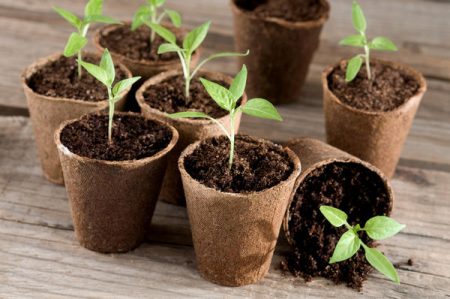
An important point in working with seedlings of pepper is the advance preparation of the soil. The soil should consist of humus, soddy soil and river sand, which acts as a baking powder. Instead of humus, you can use horse peat. In this case, organic fertilizer should be at least 30 - 45% of the entire mixture. A complex of minerals, among which superphosphate, potassium and ammonium nitrate, is not out of place, will be added to the resulting soil. At the bottom of the prepared pots or any other containers, a drainage layer is first laid, which allows you to dump excess moisture, avoiding soil oxidation.
Rules for accounting the lunar calendar when planning a pick of pepper
Pepper belongs to the category of nightshade crops, so the plant's yield primarily depends on the state of the root system and the correct picking. It is generally accepted that the moon phase directly affects all organisms consisting of water, which means that this also applies to plants.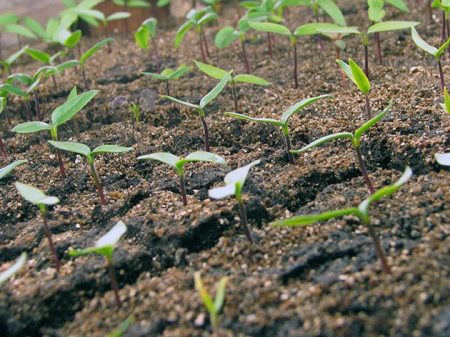
The stage of the new moon is characterized as unfavorable for the growth and development of plantings, since all the nutrient moisture is concentrated in the root system and it is too dangerous to destroy it by diving. That is why it is recommended to refrain from transplanting pepper during the new moon phase.
The phase of the growing moon is accompanied by the active growth and prosperity of plants, when all the nutrient nectar rapidly passes from the root system to leaves and flowers, and is also sent to the formation of ovaries.Due to this, at the stage of the growing moon, it is best to dive pepper seedlings at home for the purpose of further cultivation with full-fledged fruitful bushes. Even if the root part has been damaged, the plant has every chance of quickly regaining strength and continuing development.
The full moon phase is characterized by the accumulation of most useful elements in the upper part of seedlings and increased vulnerability of the root system. That is why the full moon, like the new moon, are unfavorable periods for diving pepper seedlings. And it is worth refraining from carrying out such work.
With the waning moon, nutrients gradually return to the deepest roots, giving strength for their further growth and strengthening. This stage is a neutral option for transplanting pepper into new containers, but requires maximum accuracy and attention.
Reviews
Irina Stanislavovna, 43 years old
2 to 3 days before the planned dive seedlings, additional irrigation of the soil is mandatory. It is better if they are not plentiful, but frequent. When extracting seedlings from a common container, it is better to use a spatula or spoon. This trick will allow less damage to the root system. The soil in which pepper is transplanted must be moist. For all irrigation, it is necessary to use warm, settled water with a temperature of at least 26 - 29 degrees.
Viktor Ivanovich, 52 years old
An important point in transplanting pepper plants concerns the level of falling asleep in the soil. When transplanting after a dive, the plant should be higher relative to the soil surface than it was before the separation of the root system. The requirement is due to the fact that the stem of the pepper is not able to form subordinate roots, and the lack of lighting and oxygen supply to the root part can lead to its decay. After transplanting, watering should be carried out exclusively under the root, without touching the leaves




 Calorie pepper stuffed with meat and rice - BZHU per 100 grams
Calorie pepper stuffed with meat and rice - BZHU per 100 grams Gorky pepper - the best varieties for open ground
Gorky pepper - the best varieties for open ground Hot pepper seeds - the best varieties for open ground and reviews
Hot pepper seeds - the best varieties for open ground and reviews Capsicum tincture for hair - how to use and reviews
Capsicum tincture for hair - how to use and reviews